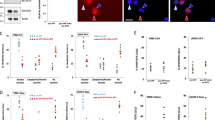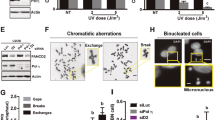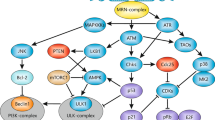Abstract
Lack of functional pRb results in attenuated recovery of mRNA synthesis and increased apoptosis following UV radiation in human breast cancer cells. We have previously demonstrated that a human breast cancer cell line, MDA-MB-468, which lacks the retinoblastoma protein (pRb), is particularly sensitive to low doses of ultraviolet (UV) radiation. These cells are 15–20-fold more sensitive to UV radiation than cells with wild-type pRb. In order to understand the mechanisms of the high apoptotic response of MDA-MB-468 cells to UV radiation, we examined the effects of UV on these cells with regards to both membrane-mediated events and DNA damage. We found that MDA-MB-468 cells were resistant to all ligand-induced death receptor signaling. In addition, although UV activated caspase 8 in MDA-MB-468 cells, a peptide inhibitor of caspase 8 failed to inhibit UV-induced apoptosis. We then tested the possibility that nuclear events mediated the enhanced sensitivity to UV-induced apoptosis in these cells. Unlike UV-resistant cells, MDA-MB-468 cells were unable to recover mRNA synthesis after 5 J/m2 UVC. We also found that the pRb-null DU-145 cells similarly had attenuated recovery of mRNA synthesis after UV radiation. In UV-resistant cells with wild-type pRb, the inactivation of pRb with HPV-16 E7 resulted in significant inhibition in their ability to recover mRNA synthesis and increased levels of apoptosis following UV radiation. Furthermore, pRb-null cells were deficient in repair of UV radiation-induced DNA damage. These data suggest that the sensitivity of MDA-MB-468 cells to UV radiation is due to defects in repair of DNA damage and recovery of mRNA synthesis rather than to membrane death receptor pathways. Inactivation of pRb may contribute to an increased sensitivity to UV radiation by attenuating repair of DNA lesions and recovery of mRNA synthesis following UV radiation.
This is a preview of subscription content, access via your institution
Access options
Subscribe to this journal
Receive 50 print issues and online access
$259.00 per year
only $5.18 per issue
Buy this article
- Purchase on Springer Link
- Instant access to full article PDF
Prices may be subject to local taxes which are calculated during checkout







Similar content being viewed by others
References
Addison CL, Hitt M, Kunsken D, Graham FL . 1997 J. Gen. Virol. 78: 1653–1661
Assefa Z, Vantieghem A, Garmyn M, Declercq W, Vandenabeele P, Vandenheede JR, Bouillon R, Merlevede W, Agostinis P . 2000 J. Biol. Chem. 275: 21416–21421
Band V, De Caprio JA, Delmolino L, Kulesa V, Sager R . 1991 J. Virol. 65: 6671–6676
Band V, Zajchowski D, Kulesa V, Sager R . 1990 Proc. Natl. Acad. Sci. USA 87: 463–467
Belka C, Heinrich V, Marini P, Faltin H, Schulze-Osthoff K, Bamberg M, Budach W . 1999a Int. J. Radiat. Biol. 75: 1257–1264
Belka C, Marini P, Lepple-Wienhues A, Budach W, Jekle A, Los M, Lang F, Schulze-Osthoff K, Gulbins E, Bamberg M . 1999b Oncogene 18: 4983–4992
Belka C, Rudner J, Wesselborg S, Stepczynska A, Marini P, Lepple-Wienhues A, Faltin H, Bamberg M, Budach W, Schulze-Osthoff K . 2000 Oncogene 19: 1181–1190
Bookstein R, Shew J, Chen P, Scully P, Lee W . 1990 Science 24: 712–715
Boyer SN, Wazer DE, Band V . 1996 Cancer Res. 56: 4620–4624
Budihardjo I, Oliver H, Lutter M, Luo X, Wang X . 1999 Annu. Rev. Cell Dev. Biol. 15: 269–290
Carlson CA, Ethier SP . 2000 Rad. Res. 154: 590–599
Carroll AG, Voeller HJ, Sugars L, Gelmann EP . 1993 Prostate 23: 123–134
Conforti G, Nardo T, D'Incalci M, Stefanini M . 2000 Oncogene 19: 2714–2720
de Laat WL, Jaspers NG, Hoeijmakers JH . 1999 Genes Dev. 13: 768–785
Fan G, Ma X, Kren BT, Rice M, Kmiec EB, Steer CJ . 1997 J. Biol. Chem. 272: 19413–19417
Ferrari D, Stepczynska A, Los M, Wesselborg S, Schulze-Osthoff K . 1998 J. Exp. Med. 188: 979–984
Game JC, Kaufman PD . 1999 Genetics 151: 485–497
Havre PA, Rice MC, Noe M, Kmiec EB . 1998 Cancer Res. 58: 4733–4739
Jones DL, Munger K . 1996 Semin. Cancer Biol. 7: 327–337
Kennedy BK, Barbie DA, Classon M, Dyson N, Harlow E . 2000 Genes Dev. 14: 2855–2868
Kulms D, Poppelmann B, Yarosh D, Luger T, Krutmann J, Schwarz T . 1999 Proc. Natl. Acad. Sci. USA 96: 7974–7979
Ljungman M, Zhang F . 1996 Oncogene 13: 823–831
Ljungman M, Zhang F, Chen F, Rainbow AJ, McKay BC . 1999 Oncogene 18: 583–592
Martini E, Roche DM, Marheineke K, Verreault A, Almouzni G . 1998 J. Cell Biol. 143: 563–575
McDougall JK . 1994 Curr. Top. Microbiol. Immunol. 186: 101–119
McKay B, Ljungman M, Rainbow A . 1998 Oncogene 17: 545–555
McKay BC, Chen F, Clarke ST, Wiggin HE, Harley LM, Ljungman M . 2001 Mutat. Res. 485: 93–105
McKay BC, Chen F, Perumalswami CR, Zhang F, Ljungman M . 2000 Mol. Biol. Cell 11: 2543–2551
McKay BC, Ljungman M . 1999 Neoplasia 1: 276–284
McKay BC, Ljungman M, Rainbow AJ . 1999 Carcinogenesis 20: 1389–1396
Rehemtulla A, Hamilton C, Chinnaiyan A, Dixit V . 1997 J. Biol. Chem. 272: 25783–25786
Rubin SJ, Hallahan DE, Ashman CR, Brachman DG, Beckett MA, Virudachalam S, Yandell DW, Weichselbaum RR . 1991 J. Surg. Oncol. 46: 31–36
Sachsenmaier C, Radler-Pohl A, Zinck R, Nordheim A, Herrlich P, Rahmsdorf HJ . 1994 Cell 78: 963–972
Sartor CI, Dziubinski ML, Yu CL, Jove R, Ethier SP . 1997 Cancer Res. 57: 978–987
Scheffner M, Romanczuk H, Munger K, Huibregtse JM, Mietz JA, Howley PM . 1994 Curr. Top. Microbiol. Immunol. 186: 83–99
Seavey SE, Holubar M, Saucedo LJ, Perry ME . 1999 J. Virol. 73: 7590–7598
Sheikh MS, Antinore M, Huang Y . 1998 Oncogene 17: 2555–2563
Slee EA, Adrain C, Martin SJ . 1999 Cell Death Differ. 6: 1067–1074
Taneja N, Tjalkens R, Philbert MA, Rehemtulla A . 2001 Oncogene 20: 167–177
Therrien JP, Drouin R, Baril C, Drobetsky EA . 1999 Proc. Natl. Acad. Sci. USA 96: 15038–15043
Webber MM, Bello D, Quader S . 1997 Prostate 30: 136–142
Wesselborg S, Engels IH, Rossmann E, Los M, Schulze-Osthoff K . 1999 Blood 93: 3053–3063
Zhu Q, Wani MA, El-Mahdy M, Wani AA . 2000 J. Biol. Chem. 275: 11492–11497
Author information
Authors and Affiliations
Corresponding author
Rights and permissions
About this article
Cite this article
Billecke, C., Ljungman, M., McKay, B. et al. Lack of functional pRb results in attenuated recovery of mRNA synthesis and increased apoptosis following UV radiation in human breast cancer cells. Oncogene 21, 4481–4489 (2002). https://doi.org/10.1038/sj.onc.1205546
Received:
Revised:
Accepted:
Published:
Issue Date:
DOI: https://doi.org/10.1038/sj.onc.1205546
Keywords
This article is cited by
-
Cellular mechanisms of tumour suppression by the retinoblastoma gene
Nature Reviews Cancer (2008)
-
Interferon regulatory factor-1-induced apoptosis mediated by a ligand-independent fas-associated death domain pathway in breast cancer cells
Oncogene (2007)
-
Transcription — guarding the genome by sensing DNA damage
Nature Reviews Cancer (2004)



